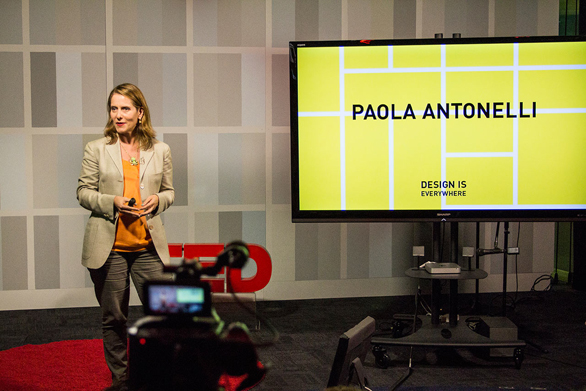
Paola Antonelli, MoMA’s design curator, talks about why she acquired 14 video games for the museum’s collection at an event in our office called “Design is Everywhere.” Photo: Ryan Lash
Whether we’re conscious of it or not, design affects us in hundreds — if not thousands of ways — each day. Just think back to your morning. A designer made the decisions that went into the craftsmanship of your bed, your futon, your mattress. A designer determined the form and materials of your toothbrush, your shower, your towel — helped create the experience of your first cup of coffee or tea. Less tangibly, a designer was involved in the way you caught up on the news or checked the weather. And that’s all before you’ve even left the house!
Design can be big — think of the subway systems or highways. Design can be small — think of the details in the fonts we stare at on screens and in books. But design is truly all around us. And so Thursday night in the TED office, we held a salon called “Design is Everywhere,” hosted by our Ideas Editor, Helen Walters. Over the course of the night, four speakers gave talks on their unique approaches to design.
First up was Jake Barton, whose media design firm Local Projects creates systems for museums to unearth works in whimsical ways, and to let the citizens of a city tell their stories in their own voice. In a very moving talk, he shared how the team approached creating the 9/11 Memorial and Museum. As Barton says, September 11 exists somewhere “between current events and history” and all of us – no matter where we were at the time — are witnesses to the event. He explained how the museum sees its mission as collecting stories of that day — even from museum visitors. He also explains how names on the memorial are arranged by an algorithm attuned to “meaningful adjacencies” of personal connections.
Next, came designer Ayşe Birsel, co-founder of Birsel + Seck, who has been called, among other things, the “Queen of Toilets,” for her innovative TOTO toilet seat. She calls her design process Deconstruction: Reconstruction. Birsel talked about her workshops, in which she asks people to rethink their greatest design product: their lives. She presented thoughtful maps and charts that different clients have made of their priorities, influences and loved ones, and how it helped them reconstruct — and ultimately express — what’s meaningful to them.
In November 2012, New York’s Museum of Modern Art acquired 14 video games for its design collection — causing a few gasps among art critics. How dare they place Pac-Man and Portal alongside Picasso and Picabia?! In a very funny talk, MoMA’s design curator Paola Antonelli makes the case that, yes, video games do belong in her museum. Why? Because, as one attendee tweets: “Video games are the purest form of interaction design.” She details how to acquire a video game for a museum (forget the game gear, get the code) and shares her wishlist for the next few acquisitions.
And finally, in a lighthearted and sharp-witted talk — the kind you could only expect from the cartoon editor for The New Yorker magazine — Bob Mankoff offered his reflections on the nature of good humor and gave tips to would-be cartoonists. (Hint: “That’s the nature of any creative activity – you’re mostly going to be rejected.”) While sharing scores of his favorite “idea drawings,” and divulging the intentions behind the magazine’s occasional abstruseness, he showed how no joke is funny unto itself. Context is everything.
“Design is Everywhere” was part of TED@250, a series of salons held at our New York office at 250 Hudson Street. Since our main conferences are only twice a year, TED@250 is an opportunity for talks that rethink headlines and respond to conversation happening in real time. It’s also a place for speakers with the kind of personal stories that simply work better on the small scale. Stay tuned. Some of these talks may be coming to TED.com.
Comments (6)
Pingback: American Steroids
Pingback: [커뮤니케이션 단신] 예술, 커뮤니케이션, 그리고 비디오게임 – “비디오게임은 커뮤니케이션의 가장 순수한 형태죠.” | Acase
Pingback: Articles of Interest May 24, 2013 « National Creativity Network
Pingback: Fuel cell symphonies and art from gift bag wrappers: The Reimagine Project launches with the TEDActive 2013 artists-in-residence | RXJ.TVRXJ.TV